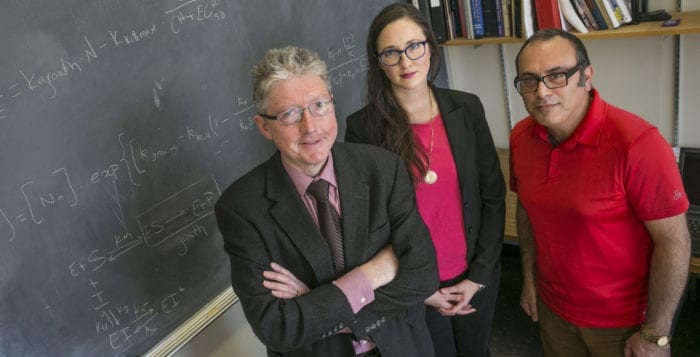By Daniel Dunaief
The journey begins at one point and ends at another. What’s unclear, however, is the process that led from beginning to end. That’s where Peter Tonge, a professor in the Department of Chemistry and Radiology at Stony Brook University’s College of Arts & Sciences, recently discovered important details.
Working with a protein called dronpa, Tonge wanted to know how the protein changed configurations as it reacted to light. There was more than one theory on how this process worked, Tonge said. “Our studies validated one of the previous hypotheses,” he said. Structural changes occur on different time scales. With a team of collaborators, Tonge was able to follow the photoreaction from absorption to the final activated form of the photoreceptor.
The technique Tonge used is called infrared spectroscopy. Through this approach, he looks at the vibration in molecules. People generally “have this picture of a molecule that isn’t moving,” he said. “In fact, atoms in the molecule are vibrating, like balls on a spring going backwards and forwards.”
Tonge uses the technique to look at vibrations before and after the absorption of light and subtracts the two. “People knew what the structure of dronpa was at the beginning and they knew the final structure,” but they had only developed educated theories about the transition from one state to another, he explained. The application of this work isn’t immediate.
“The knowledge we gained will be a foundation that will be combined with other knowledge,” Tonge said. Theoretically, scientists or drug companies can redesign the protein, fine-tuning its light-sensitive properties.
Tonge’s lab, which includes 11 graduate students, two postdoctoral researchers, two undergraduates and six high school students, explores several different scientific questions. They are studying how proteins use the energy in a photon of light to perform different biological functions.
In optogenetics, scientists have developed ways to use light to turn processes on or off. Eventually, researchers would like to figure out ways to control gene transcription using this technique. According to Tonge, scientists are “interested in using these processes that have naturally evolved to tailor them to our own purposes.”
Tonge’s other research focus involves understanding how drugs work. Most drugs fail when they reach clinical trials. “Our ability to predict how drugs will work in humans needs to be improved,” he said, adding that he focuses on something called the kinetics of drug target interactions to improve the process of drug discovery.
In kinetics, he explores how fast a drug binds to its target and how long it remains bound. Companies look to design drugs that remain bound to their desired target for longer, while separating from other areas more rapidly. This kind of kinetic selectivity ensures the effectiveness of the drug while limiting side effects.
By thinking about how long a drug binds to its target, researchers can “improve the prediction of drug activity in humans,” explained Tonge. “We need to consider both thermodynamics and kinetics in the prediction of drug activity.”
A study of kinetics can allow researchers to consider how drugs work. Understanding what causes them to break off from their intended target can help scientists make them more efficient, reducing their failure rate.
Borrowing from sports, Tonge suggested that kinetics measures how quickly an outfielder catches a ball and throws it back to the infield, while thermodynamics indicates whether the outfielder will be able to make a catch. He believes the most interesting work in terms of kinetics should occur in a partnership between academia and industry.
Tonge is the newly appointed director of the Center for Advanced Study of Drug Action at Stony Brook, where he plans to develop a fundamental understanding of how drugs work and the role kinetics play in drug action.
Joanna Fowler, a senior chemist emeritus at Brookhaven National Laboratory, worked with Tonge for several years starting in 2005. She said Tonge developed ways to label tuberculosis and other molecularly targeted molecules he had developed in his lab. They did this to image and follow it in the body using the imaging tools BNL had at the time.
In an email, she described Tonge as a “scholar” and a “deep thinker,” who investigates mechanisms that govern the interactions between chemical compounds including drugs and living systems, adding, “He uses his knowledge to address problems that affect human beings.”
Finally, Tonge is also pursuing research on positron emission tomography. He would like to synthesize new radio tracers and use PET to see where they go and learn more about how drugs work. He would also like to enhance ways to locate bacteria in humans.
The professor is trying to detect infections in places where it is difficult to diagnose because of the challenge in getting clinical samples. Samples from throat cultures or mucus are relatively easy to obtain — the short-term agony from a swab in the back of the throat notwithstanding.
“It is more difficult to get samples from locations such as prosthetic joints,” which makes it more challenging to detect and diagnose, he said.
If an infection isn’t treated properly, doctors might have to remove the prosthesis. Similarly, bone infections are difficult to detect and, if left unchecked, can lead to amputations.
A resident of Setauket, Tonge lives with his wife, Nicole Sampson, who is a professor in the chemistry department at SBU and is the interim dean for the College of Arts and Sciences, and their two children, Sebastian, 18, and Oliver, 14.
Tonge, who was raised in the United Kingdom, said he enjoys running on Long Island.
Tonge and Sampson are co-directors of a graduate student training program in which they train students to improve their ability to communicate their science. One of the activities they undertook was to visit a high school and have grad students present their research to high school students.
As for his work, Tonge said he is “genuinely curious about the chemistry that occurs in biological systems.”





